

| JOAN LA BARBARA's career as a composer/performer/sound
artist has been devoted to exploring the human voice as a multi-faceted instrument,
going far beyond traditional boundaries, creating works for multiple voices,
chamber ensembles, music theater, orchestra and interactive technology. As
an acknowledged pioneer in the field of contemporary classical music and
soundart, she developed a unique vocabulary of experimental and extended
vocal techniques, including multiphonics (the simultaneous sounding of two
or more pitches), circular singing, ululation and glottal clicks that have
become her "signature" sounds. |
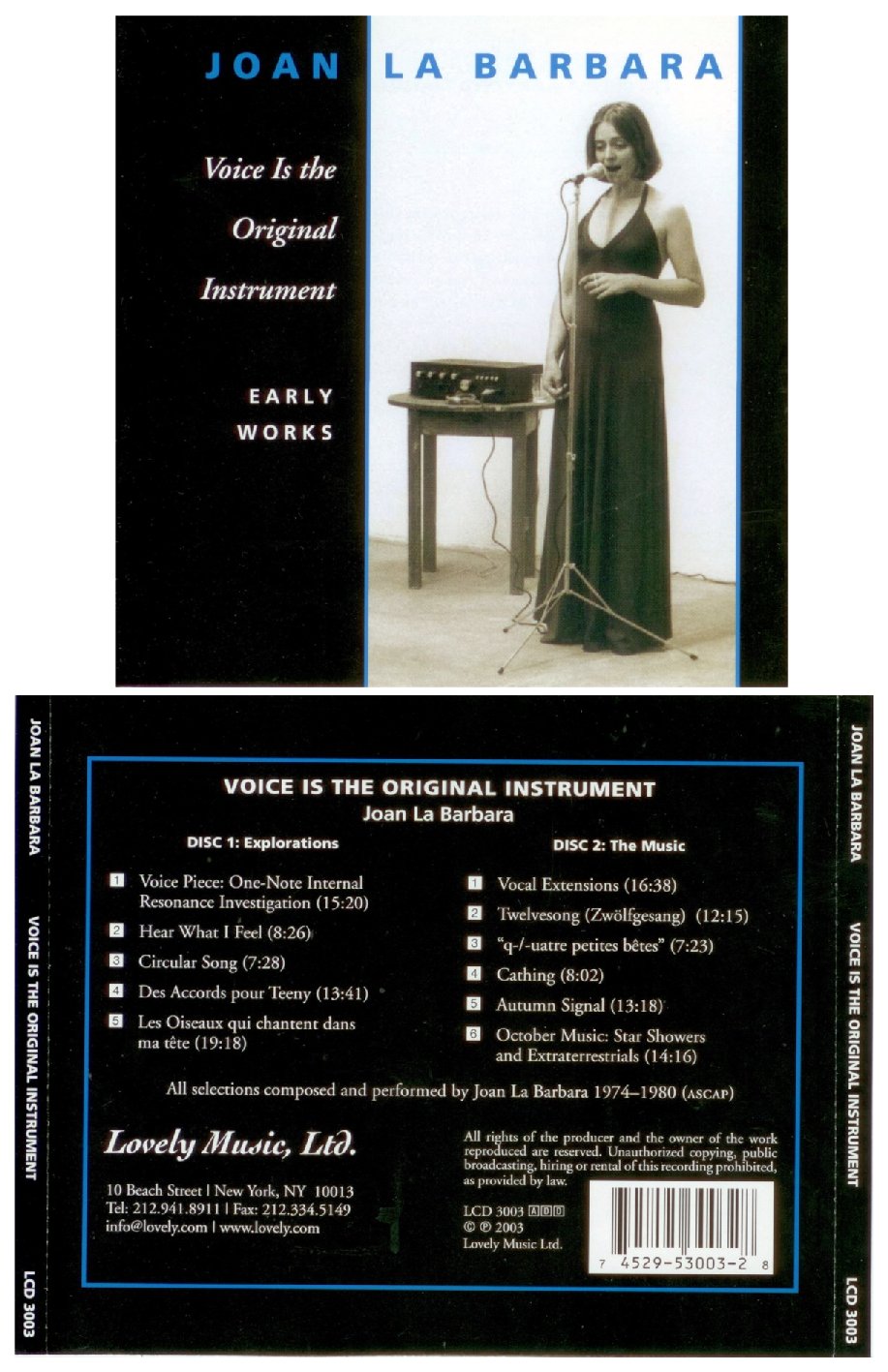 BD: Are all of your compositions written specifically
for you?
BD: Are all of your compositions written specifically
for you?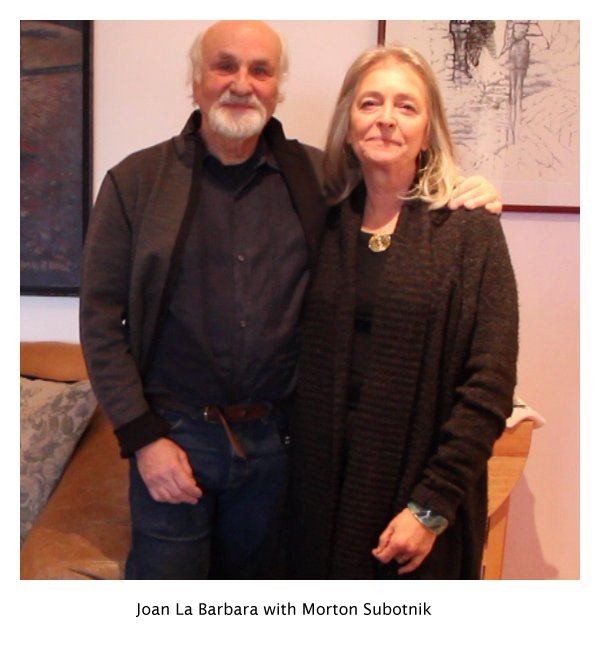 JLB: Right. What’s interesting about a singer
is that you’re constantly thinking about the sound as it’s coming back to
you from the resonance of the room. I suppose that’s the same for any
other instrument, but also because I work so much with amplified voice, a
lot of times I’m not only listening to the sound that is coming back from
the room, I’m listening to the sound as it comes into the room from speakers
while also trying to listen to the production that I’m making. So I’m
constantly shifting around between the sound that I’m producing, the sound
that is resulting from the speakers, and then the sound that is coming back
within the acoustical situation of the room. So there’s a lot of analysis
that’s going on constantly within the performance situation, in addition
to trying to handle that emotional expression of what I want to put into
music as well.
JLB: Right. What’s interesting about a singer
is that you’re constantly thinking about the sound as it’s coming back to
you from the resonance of the room. I suppose that’s the same for any
other instrument, but also because I work so much with amplified voice, a
lot of times I’m not only listening to the sound that is coming back from
the room, I’m listening to the sound as it comes into the room from speakers
while also trying to listen to the production that I’m making. So I’m
constantly shifting around between the sound that I’m producing, the sound
that is resulting from the speakers, and then the sound that is coming back
within the acoustical situation of the room. So there’s a lot of analysis
that’s going on constantly within the performance situation, in addition
to trying to handle that emotional expression of what I want to put into
music as well.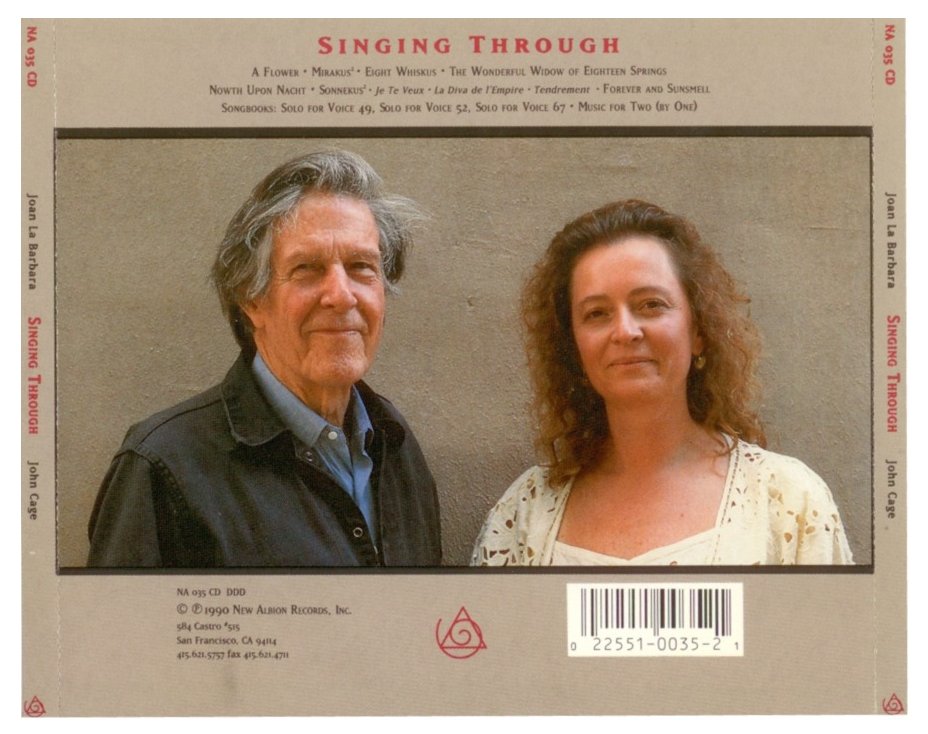 JLB: I think that because of where Cage has requested
them — in that they’re to be interspersed with his
Sonnekus², which are based
on the Book of Moses and are intended
to be in a kind of church-like setting — I really see
the Satie songs as a kind of vignette, almost as if you could see a sepia
photograph in the concert hall. It’s more like a dream or a reverie,
so to do them as if they had been written now would be not only disservice
to those songs, but also would confuse what it is that I think Cage is trying
to do, which is to juxtapose these two very, very different kinds of atmospheres.
Yet even with his songs, they’re so simple and they’re almost Gregorian chant-like.
I think of them almost like a monk walking through the cloisters.
JLB: I think that because of where Cage has requested
them — in that they’re to be interspersed with his
Sonnekus², which are based
on the Book of Moses and are intended
to be in a kind of church-like setting — I really see
the Satie songs as a kind of vignette, almost as if you could see a sepia
photograph in the concert hall. It’s more like a dream or a reverie,
so to do them as if they had been written now would be not only disservice
to those songs, but also would confuse what it is that I think Cage is trying
to do, which is to juxtapose these two very, very different kinds of atmospheres.
Yet even with his songs, they’re so simple and they’re almost Gregorian chant-like.
I think of them almost like a monk walking through the cloisters. JLB: Yes, that’s true. But if you don’t do
it, then you can’t make a CD. It’s simply a record of that particular
performance. Any jazz music disc is simply a document which is an example
of a particular reading of that idea on a particular day.
JLB: Yes, that’s true. But if you don’t do
it, then you can’t make a CD. It’s simply a record of that particular
performance. Any jazz music disc is simply a document which is an example
of a particular reading of that idea on a particular day.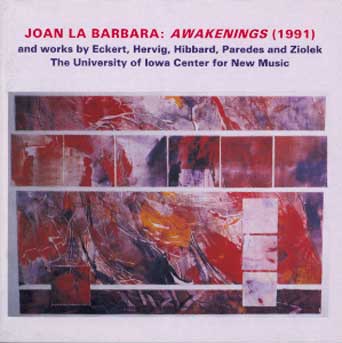 JLB: [Interrupting] ...as an entity itself.
For instance, I rarely compose totally abstractly. I don’t compose
with systems. I don’t compose with numbers. I generally will compose
from an idea. For example, the piece that I wrote for Iowa is based
on Awakenings, the book that was
turned into a movie a year or so ago. When I thought about it, it presented
a shape to me, and it was a shape that I felt that I could deal with in a
musical way. These people were in a catatonic sleep state were awakened
in some way, and when they awoke they began to have various kinds of energy
spurts. There were sudden very, very rapid movements, or certain looping
of language that’s more dealt with in the book than the movie. The movie
dealt with it very much in passing.
JLB: [Interrupting] ...as an entity itself.
For instance, I rarely compose totally abstractly. I don’t compose
with systems. I don’t compose with numbers. I generally will compose
from an idea. For example, the piece that I wrote for Iowa is based
on Awakenings, the book that was
turned into a movie a year or so ago. When I thought about it, it presented
a shape to me, and it was a shape that I felt that I could deal with in a
musical way. These people were in a catatonic sleep state were awakened
in some way, and when they awoke they began to have various kinds of energy
spurts. There were sudden very, very rapid movements, or certain looping
of language that’s more dealt with in the book than the movie. The movie
dealt with it very much in passing.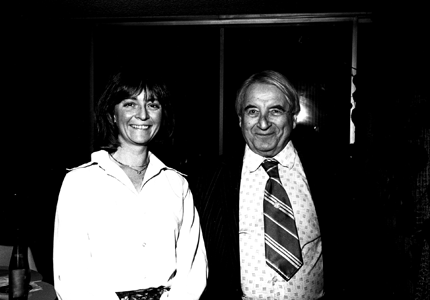 BD: Can you take any refuge in the fact that a hundred
and fifty years ago they were saying that Verdi was a voice wrecker?
BD: Can you take any refuge in the fact that a hundred
and fifty years ago they were saying that Verdi was a voice wrecker? 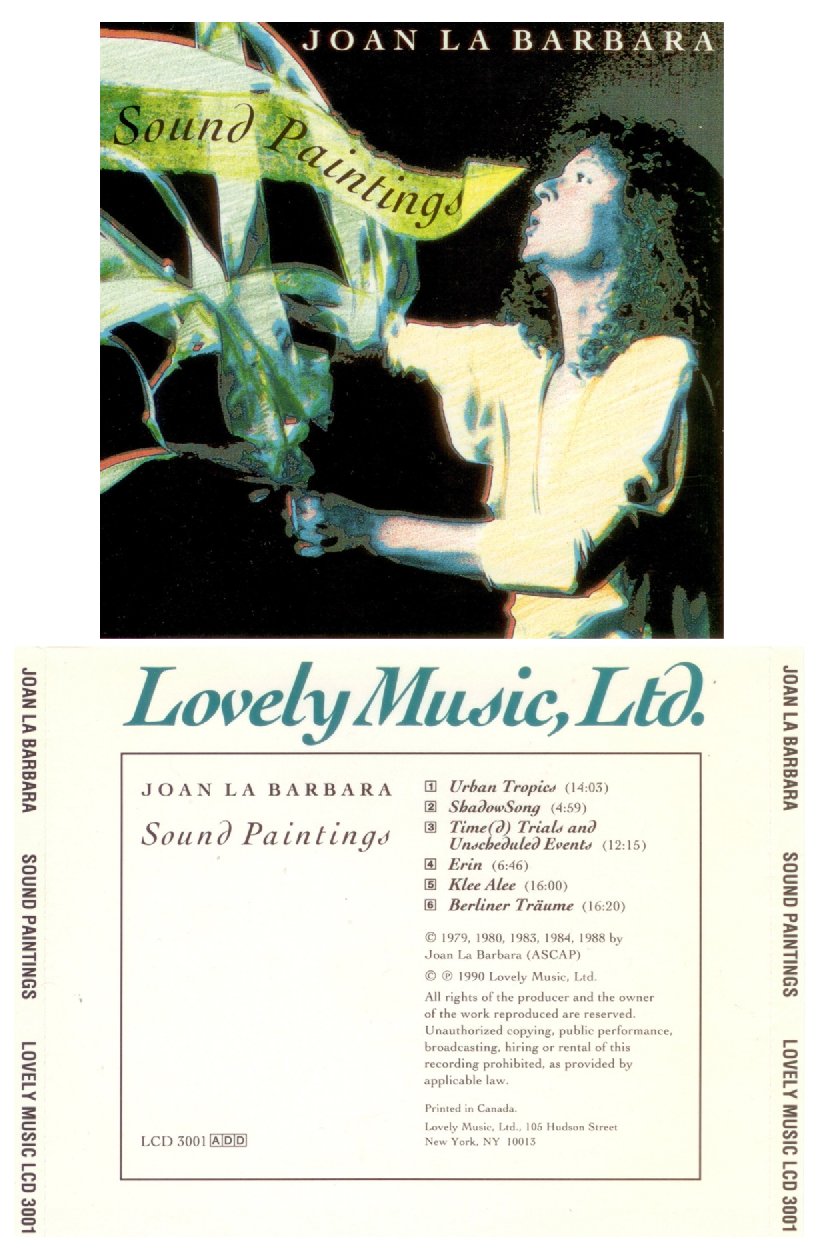 JLB: Yes, I am. I like the Cage recording
very much. I’m also very pleased with the Morton Feldman
recording, Three Voices. That’s
on New Albion and was released a couple of years ago. Sound Paintings, that I’ve just released
on Lovely Music is a wonderful document of ten years of radio pieces.
Basically those are pieces that were really designed for that medium.
Although I’ve done them in concert a lot, they were different in concert
because I add on a live vocal part to the material that’s on tape.
But I’m pleased with that.
JLB: Yes, I am. I like the Cage recording
very much. I’m also very pleased with the Morton Feldman
recording, Three Voices. That’s
on New Albion and was released a couple of years ago. Sound Paintings, that I’ve just released
on Lovely Music is a wonderful document of ten years of radio pieces.
Basically those are pieces that were really designed for that medium.
Although I’ve done them in concert a lot, they were different in concert
because I add on a live vocal part to the material that’s on tape.
But I’m pleased with that.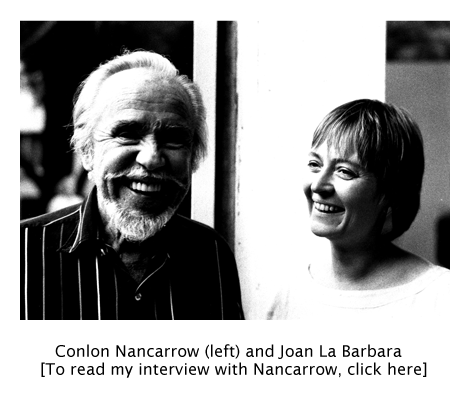 JLB: No, it isn’t. It isn’t any more of
a straightjacket than any other music is a straightjacket. If you’re
playing Chopin and something beautiful happens, you can’t just go back and
do it again because it sounded beautiful. So if a performer who’s playing
Cage hears something beautiful, you simply don’t have the right to go back
and repeat that again unless he has said you may repeat it. That really
separates the playing of John Cage’s music as he intended it from improvisation
based on John Cage. Unfortunately there are a lot of people who do
a kind of improvisation on Cage and present it as Cage, and they’re not really
presenting Cage’s material. They’re presenting their own ideas.
JLB: No, it isn’t. It isn’t any more of
a straightjacket than any other music is a straightjacket. If you’re
playing Chopin and something beautiful happens, you can’t just go back and
do it again because it sounded beautiful. So if a performer who’s playing
Cage hears something beautiful, you simply don’t have the right to go back
and repeat that again unless he has said you may repeat it. That really
separates the playing of John Cage’s music as he intended it from improvisation
based on John Cage. Unfortunately there are a lot of people who do
a kind of improvisation on Cage and present it as Cage, and they’re not really
presenting Cage’s material. They’re presenting their own ideas.| Joan La Barbara's (b. June 8, 1947
in Philadelphia) career as a composer, performer and sound artist has been
devoted to exploring the human voice as a multi-faceted instrument, going
far beyond its traditional boundaries, creating works for voices, instruments
and interactive technology. "One of the great vocal virtuosas of our time"
(San Francisco Examiner) and an important pioneer in the field of contemporary
classical music and soundart, she developed a unique vocabulary of experimental
and extended vocal techniques, including multiphonics (the simultaneous sounding
of two or more pitches), circular singing, ululation and glottal clicks that
have become her "signature" sounds. Awards and fellowships include National Endowment for the Arts, Meet The Composer, ASCAP, ISCM International Jury Award, Akustische International Competition Award and Deutscher Akademischer Austauschdienst Berliner Kunsterprogramm Composer-in-Residency, as well as numerous commissions for concert, theatre and radio works in American and Europe. Concertizing worldwide, she has appeared with the Los Angeles Philharmonic, San Francisco Symphony, New York Philharmonic, Houston Symphony, New World Symphony, Women's Philharmonic, Orchestra of The Hague, Festival d'Automne a Paris, Warsaw Autumn Festival, Frankfurt Feste, Metamusik-Berlin, Olympics Arts Festival, Brisbane Biennial, LA Festival and the American Music Theatre Festival. She has produced seven recordings of her own work, served as producer on recordings of music by John Cage and Morton Feldman and has premiered landmark compositions written for her by noted American composers, including Robert Ashley, Larry Austin, John Cage, Rhys Chatham, Charles Dodge, Morton Feldman, Philip Glass, Daniel Lentz, Mel Powell, Steve Reich, Roger Reynolds, Morton Subotnick and James Tenney. [Note: Names which are links refer to interviews by Bruce Duffie elsewhere on this website.] La Barbara has collaborated on interdisciplinary projects with various visual artists, including Lita Albuquerque, Judy Chicago, Kenneth Goldsmith, Steina and Woody Vasulka, and has completed two Meet The Composer/Reader's Digest commissions from The Gregg Smith Singers, I Cantori and The Center for Contemporary Arts in Santa Fe for a large-scale choral work, to hear the wind roar, and a collaborative interdisciplinary music-theatre piece with co-composers Morton Subotnick and Mark Coniglio, The Misfortune of the Immortals, utilizing interactive computer technology with live performers. Other recent commissions include a chamber ensemble piece, Awakenings from the University of Iowa; two radioworks: a sonic self-portrait, In the Dreamtime, and a sound painting of Cologne, Klangbild Koln, from the WestDeutscher Rundfunk-Koln; in the shadow and act of the haunting place for voice and chamber ensemble for San Francisco Contempary Music Players and Calligraphy II/Shadows for voice and Chinese instruments for Nal-Ni Chen Dance Company. Newest release: 73 Poems, a collaboration with visual/text artist Kenneth Goldsmith, an edition of prints, book and CD issued by Permanent Press and Lovely Music. Her works have been choreographed by John Alleyne for Ballet British Columbia, Martha Curtis, Catherine Kerr and Merce Cunningham ("Events"). In 1991, she composed a filmscore for "Anima", Elizabeth Harris Productions, scored for voices, middle-eastern drums, handheld percussion, cello, gamelan, keyboard synthesizers, computer and electronics. Previous filmwork includes a setting for voice with electronics for Steve Finkin's animation of the signing alphabet for "Children's Television Workshop/Sesame Street" to assist hearing children in learning to communicate with the deaf, broadcast worldwide since 1977; music for films by Richard Blau, Monica Gazzo, Elyse Rosenberg and Steven Subotnick; and composing and performing the Angel Voice for actress Emmannuelle Beart in the feature film "Date with an Angel". Her current recording projects as singer, composer and/or producer include Voice and Instruments by Morton Feldman (for New Albion), John Cage at Summerstage with Joan La Barbara, Leonard Stein and William Winant, which includes Cage's final concert performance on July 23, 1992 in NYC's Central Park, and La Barbara's own works (for Music & Arts).Soprano La Barbara premiered Morton Subotnick's opera Jacob's Room directed by Herbert Blau for the American Music Theatre Festival, New York premiere at The Kitchen and European premiere at MANCA Festival in Nice (1993-94) and premiered Robert Ashley's quartet of operas Now Eleanor's Idea (1994). La Barbara was educated at Syracuse and New York Universities, studying with Helen Boatwright, Phyllis Curtin and Marian Szekeley-Freschi. She gives workshops on extended vocal techniques and composition world wide; taught on the faculty of California Institute of the Arts (1981-86); served as Vice President of the American Music Center until 1993; co-Artistic Director of the New Music American Festival in Los Angeles (1985) and produces and co-hosts a weekly radio program, "Other Voices, Other Sounds." |
This interview was recorded at her hotel in Chicago on August 16,
1991. Portions (along with recordings) were used on WNIB
in 1992 and 1997. The transcription was made and posted on this website
in 2013.
To see a full list (with links) of interviews which have been transcribed and posted on this website, click here.
Award - winning broadcaster Bruce Duffie was with WNIB, Classical 97 in Chicago from 1975 until its final moment as a classical station in February of 2001. His interviews have also appeared in various magazines and journals since 1980, and he now continues his broadcast series on WNUR-FM, as well as on Contemporary Classical Internet Radio.
You are invited to visit his website for more information about his work, including selected transcripts of other interviews, plus a full list of his guests. He would also like to call your attention to the photos and information about his grandfather, who was a pioneer in the automotive field more than a century ago. You may also send him E-Mail with comments, questions and suggestions.